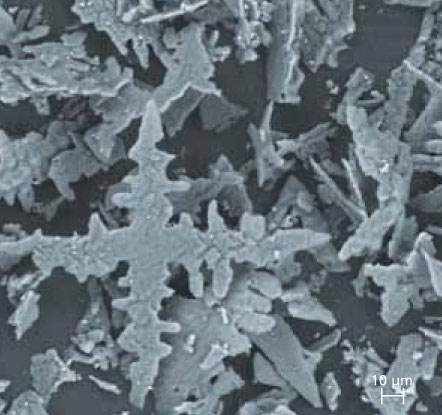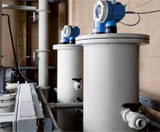The effluent from the plant could be used to irrigate and fertilize land under agricultural cultivation. The nutrients ammonium and phosphate, found in relatively high concentrations in wastewater, are hardly decomposed in bioreactors. The microbiological contamination of the effluent is low, thanks to our membrane filter, so that it can safely be used for irrigating. In May 2009, samples were taken from the effluent of the membrane filtration. There was absolutely no evidence for the existence of Escherichia coli although millions of germs per milliliter are found in reactor sludge.
DEUS 21: Recycling purified water and its nutrients
Recycling nutrients


In some cases, it is not possible to use effluent for fertilizing purposes so methods are being developed to recycle phosphate and ammonium from the effluent. An electrochemical process precipitates ammonium and phosphate as guanite struvite (MAP, magnesium-ammonium-phosphate), an excellent fertilizer due to its composition (macro nutrients N, P and Mg) and plant availability (Figs. 1, 2). Initial results from precipitation experiments carried out with filtrate from our plant in Knittlingen are more than promising. This technology has enabled us to lower the concentration of phosphate in the effluent by 93 percent to less than 1 mg/l. As the limit set by the authorities for plants for up to 100,000 residents is 2 mg/l, this gives us a secure safety margin.
Because significantly higher concentrations of ammonium are present compared to phosphate, the former is still found in the effluent after MAP precipitation. In order to recycle this as well, zeolite, a silicate mineral, is used as an ion exchanger and then regenerated with a concentrated saline solution which is subsequently treated by air stripping. This binds ammonium to sulfuric acid as ammoniac which can be recovered as ammonium sulfate for use as a fertilizer. Pilot scale experiments in Knittlingen showed that after 24 hours a 4 mg NH4-N/l level in the effluent of columns filled with zeolite was exceeded. This means that 3,600 liters of wastewater were purified at intake concentrations of 70 to 80 mg/l. When the concentration limit has been reached, (this varies depending on the level of purification required), operators can switch to a second parallel column so that the first can be regenerated.
Funding
We would like to thank the German Federal Ministry of Education and Research (BMBF) for funding the project "Decentralized Urban Infrastructure Systems DEUS 21", promotional reference 02WD0850.

 Fraunhofer Institute for Interfacial Engineering and Biotechnology IGB
Fraunhofer Institute for Interfacial Engineering and Biotechnology IGB